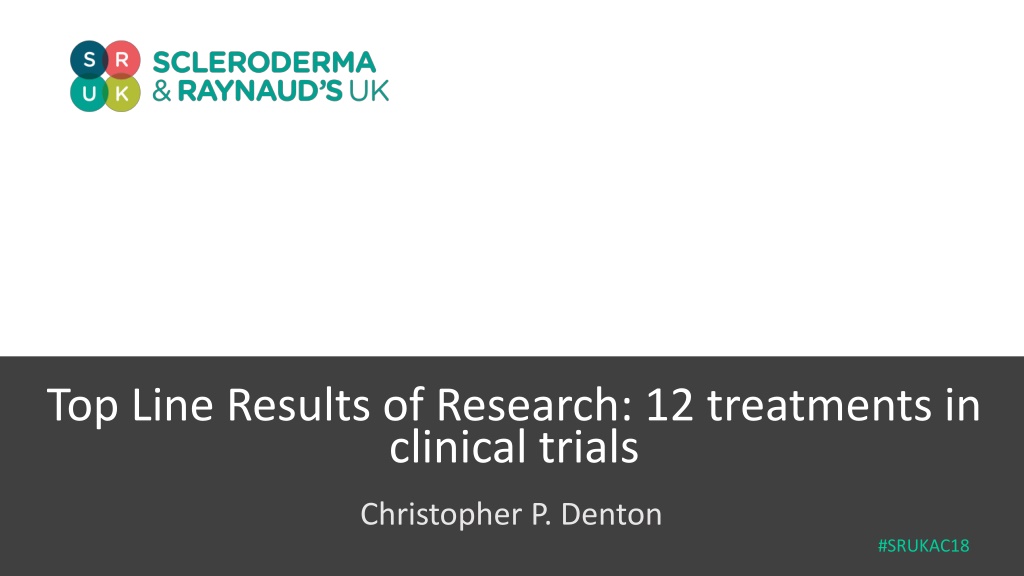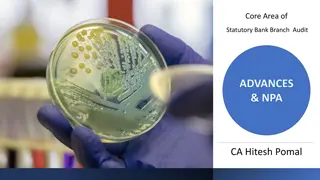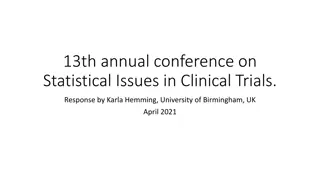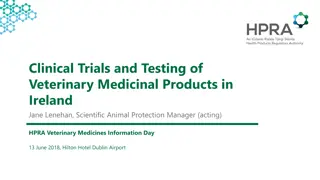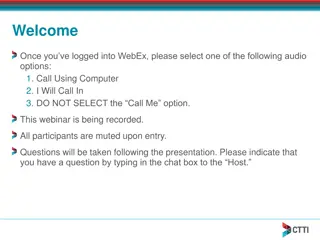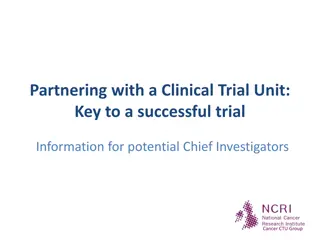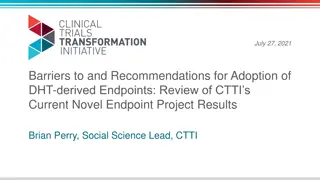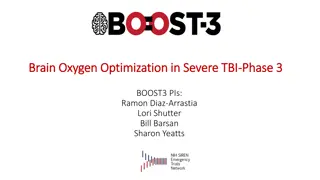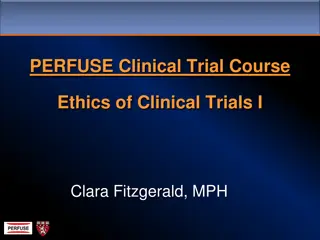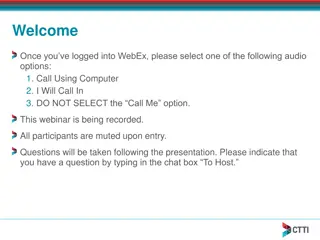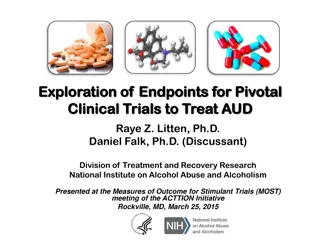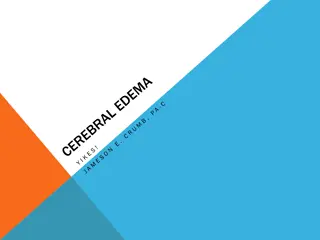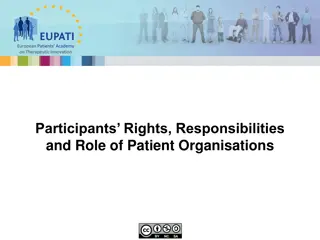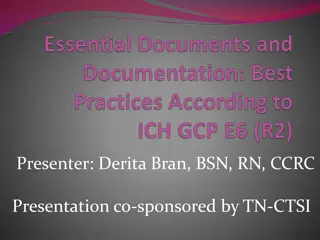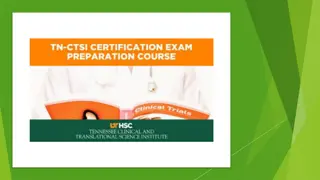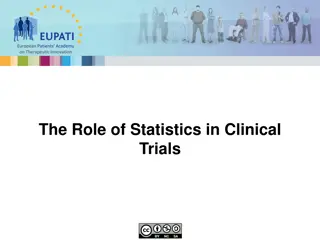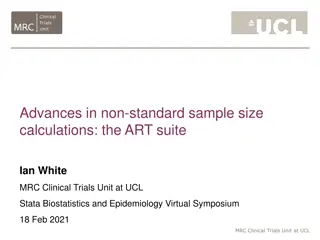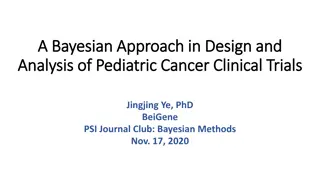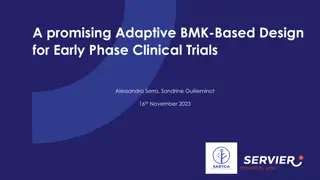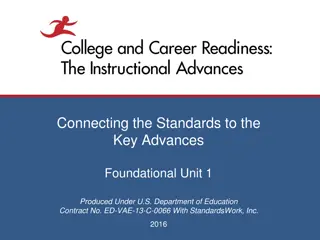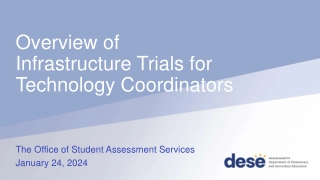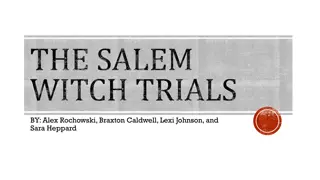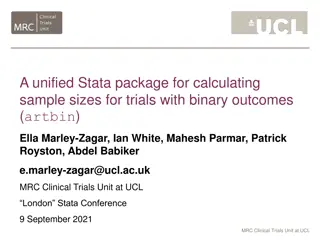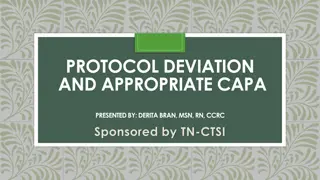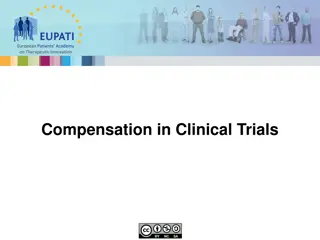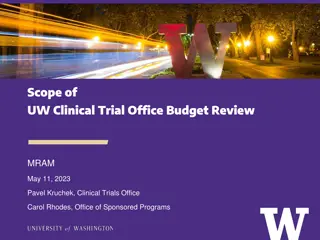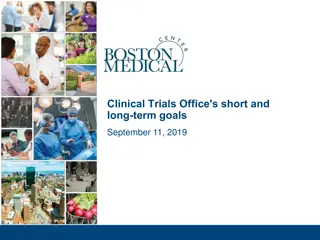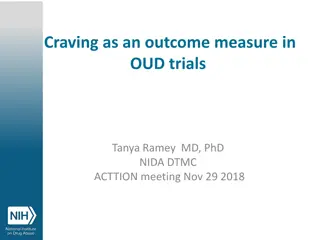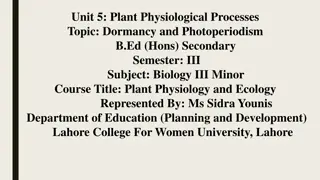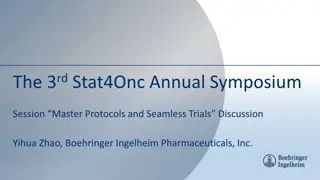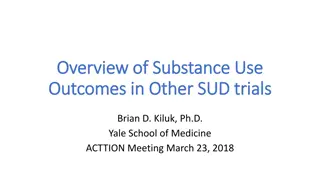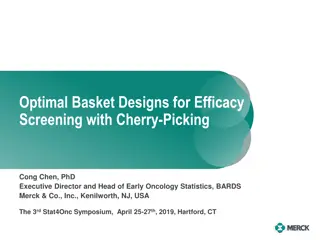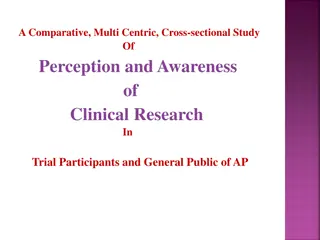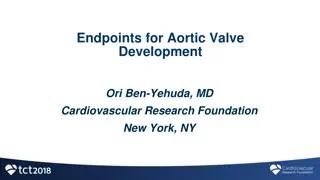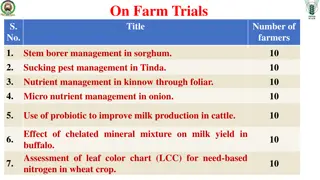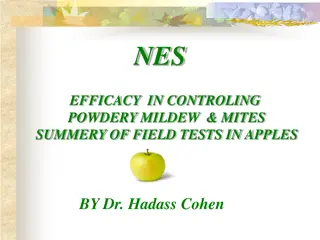Advances in Clinical Trials for Scleroderma: 12 Promising Treatments
Recent clinical trials for systemic sclerosis (SSc) show progress in utilizing broad immunosuppression for SSc skin and lung conditions. New treatments such as Nintedanib, Lenabasum, and Lanifibranor offer hope for improved outcomes. Research focuses on defining pathogenesis and exploring targeted therapies. The presentation by Christopher P. Denton highlights successful and upcoming approaches in the treatment of scleroderma.
Download Presentation

Please find below an Image/Link to download the presentation.
The content on the website is provided AS IS for your information and personal use only. It may not be sold, licensed, or shared on other websites without obtaining consent from the author. Download presentation by click this link. If you encounter any issues during the download, it is possible that the publisher has removed the file from their server.
E N D
Presentation Transcript
Top Line Results of Research: 12 treatments in clinical trials Christopher P. Denton #SRUKAC18
Disclosures Consultancy and Speakers fees: Actelion, Pfizer, GlaxoSmithKline, Bayer, Sanofi-Aventis, Inventiva, Boehringer Ingelheim, Genentech-Roche, Galapagos, Corbus, Bristol Myers Squibb, Biogen. Research grant funding: Actelion, Bayer, GSK, CSL Behring Clinical trial investigator and steering committee: Bayer, Actelion, Sanofi-Aventis, Inventiva, Boehringer Ingelheim, Genentech-Roche, Bristol Myers Squibb, Corbus, CSL Behring #SRUKAC18
Overview Recent progress in clinical trials for scleroderma (systemic sclerosis; SSc) Academic trials support use of broad immunosuppression as the best current approach for SSc skin and lung This presentation will summarise recent hits and misses and review some drugs in current trial that will soon report results. The prospect of safe and more effective treatment for skin and lung disease is within grasp. #SRUKAC18
Defining the pathogenesis in scleroderma potential for targeted therapy Serotonin Adenosine Leukotrienes Cannabinoids LPA Peptide and small molecule mediators Prostanoids (PGE2, PGI2) Endothelin Immune cell subpopulations Co-stimulatory molecules CD80 CD86 CD20 PDGF OSM IL-11 IL-31 TGF CCL2, CCL7 IL-17 IL-13 IL-1 IL-6 av 6 integrin PPAR agonists Wnt Hedgehog MRTFA Tyrosine kinase Cytokines and growth factors CTGF (CCN2) VEGF Notch Integrin and cytokine signalling Morphogen pathways Phosphodiesterase cGMP Jak-STAT Smad MAPK Epigenetic pathways Epigenetic mechanisms CGTF=connective tissue growth factor; IL=interleukin; LPA= Lysophosphatidic acid; OSM=oncostatin M PDGF=platelet-derived growth factor; PPAR=peroxisome proliferator-activated receptor TGF =transforming growth factor beta Denton CP. Clinical Medicine 2016;16: 55 60
12 clinical trials in scleroderma recent progress The future Nintedanib Lenabasum Lanifibranor Riociguat OSM inhibitor Tocilizumab Abatacept The past Immunosuppression Stem cell transplant (HSCT) Rutuximab Imatinib Anti-TGFbeta #SRUKAC18
European Scleroderma Observational Study (ESOS) Immunosuppression for skin in scleroderma Current Issue Skin score over time, by treatment protocol Cyclo then MMF ATG then MMF MMF 50 40 30 Modelled skin score change from baseline mean 21 (17-26) adjusted for confounders 20 Herrick et al, J Rheum (2010); 37: 116-24. 10 0 mRSS BaselineYear1 Year2 Year3 BaselineYear1 Year2 Year3 BaselineYear1 Year2 Year3 147 patients from 12 centres No difference between protocols Intention to treat analysis Deterioration usually led to intensified therapy No active therapy Other (MTX etc) 50 40 30 20 10 0 ESOS EULAR-ODP funded MTX, cyclophosphamide, MMF n=326 subjects results reported 2016 BaselineYear1 Year2 Year3 BaselineYear1 Year2 Year3 Herrick et al, J Rheum (2010); 37: 116-24. Herrick AL, Denton CP et al. Ann Rheum Dis. July2017 ;76:1207-1218
Cyclophosphamide for lung fibrosis in SSc Fibrosing alveolitis in scleroderma trial (FAST)1monthly intravenous cyclophosphamide 600mg/m2 for 6 months followed by (po) azathioprine, or placebo in 45 patients Over 12 months FVC change favoured active treatment (p=0.04, BMI corrected uncorrected p=0.08) Magnitude of difference 5.5% (4.8% adjusted) active arm improved (+2.5 % predicted) placebo arm worsened (-3.0 % predicted) FAST primary outcome: FVC Absolute FVC (mean at each time point) 2.64 2.62 2.60 2.58 p=0.08 2.56 2.54 2.52 2.50 2.48 PLACEBO ACTIVE 2.46 2.44 12months baseline 3 months 6 months 9 months Months from baseline 1Hoyles et al Arthritis Rheum 2006; 54:3962-70
Figure 3 SLS II Trial (USA) confirms benefit for MMF and cyclophosphamide for lung fibrosis in SSc 24 month treatment effect Average change in %-predicted FVC for observed values (mean +SE): CYC: 3.0+1.2 MMF: 3.3+1.1 n=51 n=58 n=36 n=49 Post hoc pooled cohort (MMF+ CYC) data analysis from SLS I & II showed statistically significant improvements in mRSS compared to SLS-I placebo at 12-, 18-, and 24- month period (p< 0.05). Namas et al, Arthritis Care Res. 2017 doi: 10.1002/acr.23282 The Lancet Respiratory Medicine 2016 4, 708-719DOI: (10.1016/S2213-2600(16)30152-7) Tashkin DP, et al. Lancet Respir Med. 2016 Jul 25. pii: S2213-2600(16)30152-7. Denton CP. Lancet Respir Med. 2016 Jul 25. pii: S2213-2600(16)30191-6.
Autologous haematopoetic stem cell transplanation (HSCT) for diffuse cutaneous SSc Intensive immunosuppression may lead to long term improvement in outcome for dcSSc ASCT allows high dose cyclophosphamide with rapid recovery from myelosuppression Registry data supportive but highlighted treatment related mortality Prospective controlled trials: ASSIST (n=19) Lancet 2011 ASTIS in Europe (n=156) JAMA, 2014 SCOT trial in USA (n=75) NEJM, 2018 Results now reported and all three studies favour HSCT for long term survival
Myeloablative autologous transplantation (HSCT) versus monthly intravenous Cyclophosphamide (CYC) for severe scleroderma: SCOT trial Seventy-five subjects were randomized (n=39 CYC, n=36 HSCT) with mean baseline mRSS=30 mean FVC=74% mean DLC0=53% of predicted Transplant related mortality 3% Sullivan KM et al, N Engl J Med. 2018 Jan 4;378(1):35-47.
Rituximab for connective tissue disease associated lung fibrosis FVC Dlco Eur Respir J. 40(3):641-8. Severe interstitial lung disease in connective tissue disease: rituximab as rescue therapy. Keir GJ, Maher TM, Hansell DM, Denton CP, Ong VH, Singh S, Wells AU, Renzoni EA.
RECITAL A randomized, double blind controlled trial comparing Rituximab against intravenous Cyclophosphamide in Connective Tissue Disease (CTD) associated Interstitial Lung Disease (ILD) RTX versus cyclophosphamide as initial therapy for SSc (CTD) associated lung fibrosis SSc, MCTD, IIM Study design No background immunosuppression or previous treatment with cyclophosphamide or rituximab SSc-PF fulfil Goh et al (2009) criteria for extensive disease n=116 Primary end point: absolute change in FVC at 24 weeks Study recruiting
Anti-TGF1 therapy for diffuse cutaneous systemic sclerosis testing metelimumab (CAT-192) Antibody protein (variable region) Phage-display antibody technology Change in mRSS from baseline to Placebo (n=9) (n=9) Human antibody gene sequences are inserted into a population of phages. month 6 (+/- 6 weeks) 0.5 mg/kg Each phage carries the genes for a different antibody and thus displays a different antibody on its surface Antibody genes CAT-192 is a recombinant human IgG4 with specific neutralising activity against human TGF 1 5 mg/kg (n=7) 10 mg/kg (n=7) Denton et al Arthritis Rheum 2007, 56:323-33 (2007)
12 clinical trials in scleroderma recent progress The future Nintedanib Lenabasum Lanifibranor Riociguat OSM inhibitor Tocilizumab Abatacept The past Immunosuppression Stem cell transplant (HSCT) Rutuximab Imatinib Anti-TGFbeta #SRUKAC18
Nintedanib for systemic sclerosis lung fibrosis Nintedanib is a broad spectrum tyrosine kinase inhibitor (blocks bFGF, PDGF, VEGF and others) Used as a chemotherapy to treat advanced lung cancer Licensed anti-fibrotic treatment for idiopathic lung fibrosis Strong rationale for benefit in systemic sclerosis supported by pre-clinical data from laboratory models1 1Huang J Distler JH. Ann Rheum Dis. 2016, 75:883-90.
SENSCIS (Safety and Efficacy of Nintedanib in Systemic SClerosIS) Phase III Nintedanib in SSc associated lung fibrosis Small molecule triple angio-kinase inhibitor (PDGF, bFGF, VEGF) Licensed drug for IPF Beneficial effects in preclinical models Large Phase III trial (n=520) Explores the efficacy and safety of nintedanib 150 mg bid in treating patients with SSc-ILD, compared with placebo. The trial will be conducted as a double blind, randomised, placebo-controlled trial with primary efficacy evaluation at week 52 and placebo-controlled treatment until last patient out (up to a maximum of 100 weeks). Outcome data expected November 2018
Lenabasum JBT-101 (ajulemic acid now designated as Lenabasum) Promotes release of resolution promoting/anti-inflammatory eicosanoids CB2 cannabinoid agonist Stimulates PPARgamma antifibrotic Reduces markers of fibrosis and pro- inflammatory cytokines (CTGF, IL6) in SSc fibroblasts CORBUS Pharmaceuticals CB2 agonist that may have anti-inflammatory and anti-fibrotic potential Phase 2 study Positive results reported November 2016 Statistically significant benefit for CRISS composite index RESOLVE trial now underway (Phase 3)
Lenabasum Results of a clinical trial of lenabasum in SSc Phase I/II trial of JBT-101 Corbus pharmaceuticals 2017 EULAR Oral presentation June 2017
Lanifibranor Stimulating nuclear receptors PPAR agonist IVA337 (now re-named lanifibranor) stimulates activity of nuclear receptor called the PPARs, that are important in cellular metabolism and reduced in several diseases including diabetes. Numerous reports in the literature suggest a link between PPARs and fibrosis and the possibility of using PPAR agonists as antifibrotic therapies (Lakatos 2007, Bhattacharyya 2012, Wei 2011, and Wei 2012). Evidence suggests reduced expression of PPARs in SSc (Varga 007, Ghosh 2004). A decreased expression of PPAR was also reported in scleroderma lung fibroblasts (Bogatkevich et al 2012) indicating that PPAR repression is a common feature of fibrotic organs in SSc.
Lanifibranor FASST - lanifibranor Proof-of-concept Phase II trial of IVA337 in Diffuse Cutaneous Systemic Sclerosis (FASST) n=132 placebo, IVA337 400mg bid and IVA337 600mg bid IVA337 is a pan-PPAR agonist Anti-fibrotic potential Effective in pre-clinical models (Derrett-Smith et al 2018 ACR presentation) Design Placebo controlled study Permits stable background immunosuppression Primary end-point mRSS change at 48 weeks Outcome data expected late 2018
Riociguat potential treatment for skin and vasculopathy in SSc Riociguat is a novel sGC stimulator approved for the treatment of PAH in several countries1 3 Riociguat significantly improved 6MWD and several secondary endpoints in PAH in the PATENT-1 study4 6MWD and WHO FC improvements were maintained for up to 2 years in the PATENT-2 long-term extension study5,6 PAH-SSc cases were included in the PATENT-1 and -2 clinical trials 1. Riociguat US prescribing information; 2. Riociguat EU SmPC; 3. Conole D, Scott LJ. Drugs 2013;73:1967 1975; 4. Ghofrani HA, et al. N Engl J Med 2013;369:330 340; 5. Rubin LJ, et al. Eur Respir J 2015;45:1303 1313; 6. Rubin LJ, et al. Eur Respir J 2014;44(Suppl. 58):1803 6MWD, 6-minute walking distance; CTD, connective tissue disease; PAH, pulmonary arterial hypertension; sGC, soluble guanylate cyclase; WHO FC, World Health Organization functional class
Antifibrotic effect of riociguat - RISE-SSc Riociguat is a soluble guanylate cyclase agonists licensed for PAH and CTEPH and effective in CTD-PAH Persuasive pre-clinical evidence for anti-fibrotic effect of riociguat in skin related to increase in intracellular cGMP Phase II trial n = 130 (fully recruited 2016) Primary end-point change in mRSS baseline to week 52 Innovative study design to enrich for progressive skin mRSS >10 and <22 disease duration < 18 months Primary completion date Results for presentation at ACR Conference October 2018
Targeting the IL-6 axis in diffuse systemic sclerosis IL-6 serum level in SSc IL-6 serum level at presentation predicts skin score at 36 months 50 40 40 IL-6 (pg/ml) MRSS at 36 months 30 30 20 20 r=0.86 p<0.01 10 * 10 0 dcSSc High plts dcSSc Normal plts Controls lcSSc 0 0 10 20 30 40 50 IL-6 (pg/ml) IL-6 serum level at presentation predicts survival 100 Low IL-6 80 Survival % 60 40 high 20 p=0.02, Log rank analysis 0 0 60 120 180 Disease duration (months) 15 5 3 1 24 15 5 1 Number at risk High Low Khan et al. Ann Rheum Dis. 2012;71:1235-42.
Phase II clinical trial supports benefit for tocilizumab (anti-IL6R) for skin and lung fibrosis in scleroderma (faSScinate) Skin response Lung response FVC change cumulative distribution plot MRSS change over 48 weeks Two gene SSc skin biomarker 24 weeks 24 weeks p=0.009 Weighted values for THBS1 and MS4A4A mRNA expression PBO 19% 3% TCZ -10% 0 p=0.06 p=0.10 Biomarker skin score achieves statistical significance for treatment effect at 24 weeks Similar results for FVC at 48 weeks (p=0.03) Khanna D, Denton CP et al. Lancet. 2016, 387:2630-40
FocuSSced Phase III Blocks IL6R signalling direct and trans-signalling Phase III study of TCZ in dcSSc Following from encouraging Phase II data from FaSScinate n=210 48 week double blind placebo controlled trial of TCZ 162mg weekly by subcutaneous injection No background immunosuppression (rescue from 24 weeks) 48 week open label extension Primary end point change in mRSS baseline to week 48 Outcome data for presentation at ACR October 2018
Targeting Oncostatin M (OSM) in systemic sclerosis GSK2330811 proof of mechanism in early dcSSc Patient cohorts Cohort 1: repeat-dose for submaximal inhibition Cohort 2:repeat-dose for maximal inhibition Background MMF allowed Assessments Skin biopsy +/- blister fluid, spirometry 24-40 recruitment target with 3:1 active: placebo Treatment period 12 weeks Cohort 2 is now being actively recruited in UK and USA
ASSET Abatacept Systemic SclErosis Trial Blocks T cell co-activation signalling Phase II study (n=86) Trial of abatacept in 125mg sc weekly or placebo in active dcSSc over 52 weeks Placebo controlled No background immunosuppression Primary end point change in mRSS baseline to week 52 Outcome data to be presented at ACR in October 2018
The new challenge building upon recent achievements In the past nothing seemed to work now we have much more optimism Progress has been made in clinical trial design Choosing the most informative study cohort Better understanding of endpoints Better understanding of disease biology and relevant drug targets We now have excellent candidate therapeutics supported by strong preclinical science and mechanistic studies Recent well powered studies have been almost positive evaluating treatments that almost certainly work Group level MRSS change has not fulfilled expectation trials can be improved HSCT sets a new standard of treatment effect Targeted therapies may need to be used in combination PAH analogy
Many thanks to . Our patients The Scleroderma team at Royal Free Research Funders Colleagues in many institutions and organisations UKSSG colleagues International collaborators EUSTAR, WSF, SCTC and FESCA
